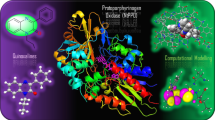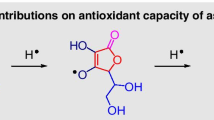Abstract
Chlorogenic acid, 3’-O-caffeoyl D-quinic acid, is an inherent ligand present inHelianthus annuus L. The effect of pH on chlorogenic acid binding to helianthinin suggests that maximum binding occurs at pH 6.0. The protein-polyphenol complex precipitates as a function of time. The association constant of the binding of chlorogenic acid to helianthinin, determined by equilibrium dialysis, at 31°C has a value of 3.5 ± 0.1 × 104M−-1 resulting in a ΔG value of − 6.32 ± 0.12 kcal /mol. The association constantK ais 1.0 ± 0.1 × 104M−1 as determined by ultraviolet difference spectral titration at 25°C with ΔG° of -5.46 ± 0.06 kcal/mol. From fluorescence spectral titration at 28°C, theK avalue is 1.38 ± 0.1 × 1 0 4M−1 resulting in a ΔG of − 5.70 ± 0.05 kcal/mol. The total number of binding sites on the protein are 420 ± 50 as calculated from equilibrium dialysis. Microcalorimetric data of the ligand-protein interaction at 23°C suggests mainly two classes of binding. The thermal denaturation temperature,T mof the protein decreases from 76°C to 72°C at 1 × 10−3M chlorogenic acid concentration upon complexation. This suggests that the complexation destabilizes the protein. The effect of temperature onK aof chlorogenic acid shows a nonlinear increase from 10.2°C to 45°C. Chemical modification of both lysyl and tryptophanyl residues of the protein decreases the strength of binding of chlorogenic acid. Lysine, tryptophan and tyrosine of protein are shown to be present at the binding site. Based on the above data, it is suggested that charge-transfer complexation and entropically driven hydrophobic interaction are the predominant forces that are responsible for binding of chlorogenic acid to the multisubunit protein, helianthinin.
Similar content being viewed by others
References
AOAC 1984Official methods of analysis of the association of official analytical chemists (ed.) S William 14th edition (Virginia; Association of Official Analytical Chemists)
Barnes H M, Feldman J R and White W V 1950 Isochlorogenic acid. Isolation from coffee and structure studies;J. Am. Chem. Soc. 72 4178–4182.
Birdsall B, Dunlap R B, Goode S R, King R W, Lewis C A, Roberts G C K and Wheeler MR 1983 Correction for light absorption in fluorescence studies of protein-ligand interactions;Anal. Biochem. 132 353–361
Cantor C R and Schimmel P R 1980 Ligand interactions at equilibrium; inBiophysical chemistry PartIII (eds) C R Cantor and P R Schimmel (San Francisco: W H Freeman) Chapter 15, p 864
Dahlquist F W 1978 The meaning of Scatchard and Hill plots;Methods Enzymol. 48 270–299
Feeny P P 1969 The inhibitory effect of oak leaf tannin on the hydrolysis of proteins by trypsin;Phytochemistry 8 2119–2126
Goldstein J L and Swain T 1965 The inhibition of enzymes by tannins;Phytochemistry 4 185–192
Hall R J, Trinder N and Givens D I 1973 Observations of the use of 2,4,6-trinitro benzene sulphonic acid for the determination of available lysine in animal protein concentrates;Analyst 98 673–686
Haslam E and Lilley T 1988 Natural astringency in foodstuffs — A molecular interpretation;CRC Crit. Rev. Food Sci. Nutr. 27 1–40
Hjerten S, Rosengren J and Pahlman S 1974 Hydrophobic interaction chromatography: The synthesis and the use of some alkyl and aryl derivatives of agarose;J. Chromatogr. 101 281–288
Klotz I M, Walker F M and Pivan R B 1946 The binding of organic ions by proteins;J. Am. Chem. Soc.,68 1486–1490
Klotz I M 1967 Succinylation;Methods Enzymol. 11 576–580
Kronman M J and Robbins F M 1970 Burned and exposed groups in proteins; inFine structure of proteins and nucleic acids (eds) G D Fasman and S N Timasheff (New York: Marcel Dekker) Chapter4, pp 271–416
Kumar R and Singh M 1984 Tannins: Their adverse role in ruminant nutrition;J. Agric. Food Chem. 32 447–453
Lehrer S S and Fasman G D 1966 The fluorescence of lysozyme and lysozyme substrate complexes;Biochem. Biophys. Res. Commun. 23 133–138
Loomis W D and Battaile J 1966 Plant phenolic compounds and the isolation of plant enzymes;Phytochemistry 5 423–438
Loomis W D 1974 Overcoming problems of phenolics and quinones in the isolation of plant enzymes and organelles;Methods Enzymol. 31 528–544
Ludlum C T, Felton G W and Duffey S S 1991 Plant defenses. Chlorogenic acid and polyphenol oxidase enhance toxicityof Bacillus thuringiensis sub sp. kurstaki toHeliothis zea;J. Chem. Ecol. 17 217–237
Mole S and Waterman P G 1986 Tannic acid and proteolytic enzymes: Enzyme inhibition or substrate deprivation?;Phytochemistry 26 99–102
Oberfelder R W and Lee J C 1985 Measurement of Ligand — Protein interaction by electrophoretic and spectroscopic techniques;Methods Enzymol. 117 381–399
Oh H I, Hoff J E, Armstrong G S and Haff L A 1980 Hydrophobic interaction in tannin — protein complexes;J. Agric. Food Chem. 28 394–398
Pierpoint W S 1969a O-Quinones formed in plant extracts. Their reactions with amino acids and peptides;Biochem. J. 112 609–618
Pierpoint W S 1969b O-Quinones formed in plant extracts. Their reaction with bovine serum albumin;Biochem. J. 112 619–629
Prakash V and Rao MSN 1986 Physicochemical properties of oilseed proteins;CRC Crit. Rev. Biochem. 20 264–363
Prasad D T 1990 Proteins of the phenolic extracted sunflower meal: 1. Simple method for removal of polyphenolic components and characteristics of salt soluble proteins;Lebensm.-Wiss. u. Technol. 23 229–235
Rahma E H and Rao MSN 1981 Isolation and characterization of the major protein fraction of sunflower seeds;J. Agric. Food. Chem. 29 518–521
Sabir M A, Sosulski F W and Kernan J A 1974 Phenolic constituents in sunflower flour;J. Agric. Food Chem. 22 572–578
Scatchard G 1949 Attraction of proteins for small molecules and ions;Ann. N. Y. Acad. Sci. 51 660–672
Schachman. H K 1959 Sedimentation velocity; inUltracentrifugation in Biochemistry (ed.) H KSchachman (New York: Academic Press) Chapter 4, pp 63–180
Spande T F and Witkop B 1967 Determination of the tryptophan content of proteins with N-bromosuccinimide;Methods Enzymol. 11 498–506
Steinhardt J and Reynolds J A 1969Multiple Equilibria in Proteins (New York: Academic Press)
Teale F W J and Weber G 1957 Ultraviolet fluorescence of the aromatic amino acids;Biochem. J. 65 476–482
Van Buren J P and Robinson W B 1969 Formation of complexes between protein and tannic acid;J. Agric. Food Chem. 17 772–777
Ward L D 1985 Measurement of ligand binding to proteins by fluorescence spectroscopy,Methods Enzymol. 117 400–414
Author information
Authors and Affiliations
Additional information
Publication No. 324.
Rights and permissions
About this article
Cite this article
Suryaprakash, P., Prakash, V. Interaction of 3’-O-caffeoyl D-quinic acid with multisubunit protein helianthinin. J. Biosci. 20, 531–549 (1995). https://doi.org/10.1007/BF02703536
Received:
Revised:
Published:
Issue Date:
DOI: https://doi.org/10.1007/BF02703536




